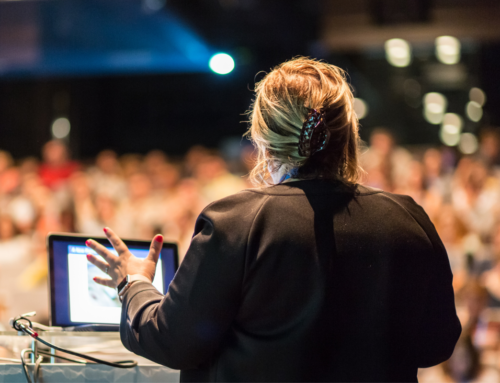I spoke this week at a conference of CIOs, talking about authentic communications. It’s a new version of a speech I’ve given before, but it was time to update it to take into account the latest brain research I talk about in my new book, Trust Me: Four Steps to Authenticity and Charisma – and to take my own medicine.
I’m most comfortable in the seminar format, as a former academic, and I like to have 3 or more hours, a video camera, and lots of interaction. Now, the structure of a seminar is necessarily different from a keynote speech of an hour or less. You have to involve the audience more, so that they don’t go crazy with passivity. And you’re better served to divide the time up into a series of mini-speeches in terms of structure, each with its own beginning, middle and end.
But here I was giving a keynote speech – 45 minutes plus a few questions. I had to figure out what to jettison, and how to apply my own advice about structure to a format with necessarily less interaction. There simply isn’t time to prepare for, videotape and play back audience mini-speeches during the course of 45 minutes and still say something of substance. You can – and should – have audience interaction, but it can’t go on that long.
Moreover, while I’m all for audience volunteers, my group was somewhere between 200 and 250, and it was not going to work for the rest of the audience if I spent a third of my time with one or two representative extroverts.
The first thing I did was think about what my elevator speech was. If I could focus all that brain research and communications work into one point, I was on the road to developing a focused 45-minute talk.
So, I settled on the following: Audiences today will not be moved to action unless your presentations are authentic, and I will show you how to achieve that authenticity, based on the latest communications and brain research.
That could probably be improved, but time was tight and it was good enough to go on. Then, I had to figure out what the problem was that the audience had for which my material was the solution. That was easy enough; the conference organizer and I had already worked that out. The CIOs were all deeply involved in change programs, given the economy and the fast-changing world of IT, and they wanted to know how to make change work. My answer was that authentic appeals to their employees would work; inauthentic ones would not.
That meant that I had to spend the first half of the talk, roughly, laying out the problem of inauthentic communications. I used a number of humorous videos to show what inauthentic communications looked like, and I began with a quick set of three questions for the audience, and a story of authentic communications to get things rolling.
Then, the second half of the speech was all about how to do it right, with lots of group audience participation. I had to compress both sections greatly from my seminar format, focusing on a severely limited set of examples, but that was good discipline.
The result? I kept a close eye on timing, and felt briefly like James Bond as I uttered my last sentence and said “thank you” just as the giant red digital clock on the monitor counted down to zero. Nothing exploded, the audience applauded nicely, and it all went accordingly to plan.
There’s real satisfaction in delivering a keynote speech to plan. Thanks to the CIO Magazine conference group for providing the opportunity. And thanks to the CIOs for being a great audience. A 45-minute speech is all about focus. From the elevator speech to the closing seconds, keep your eye on the prize: getting one point across as clearly as possible.











Leave A Comment